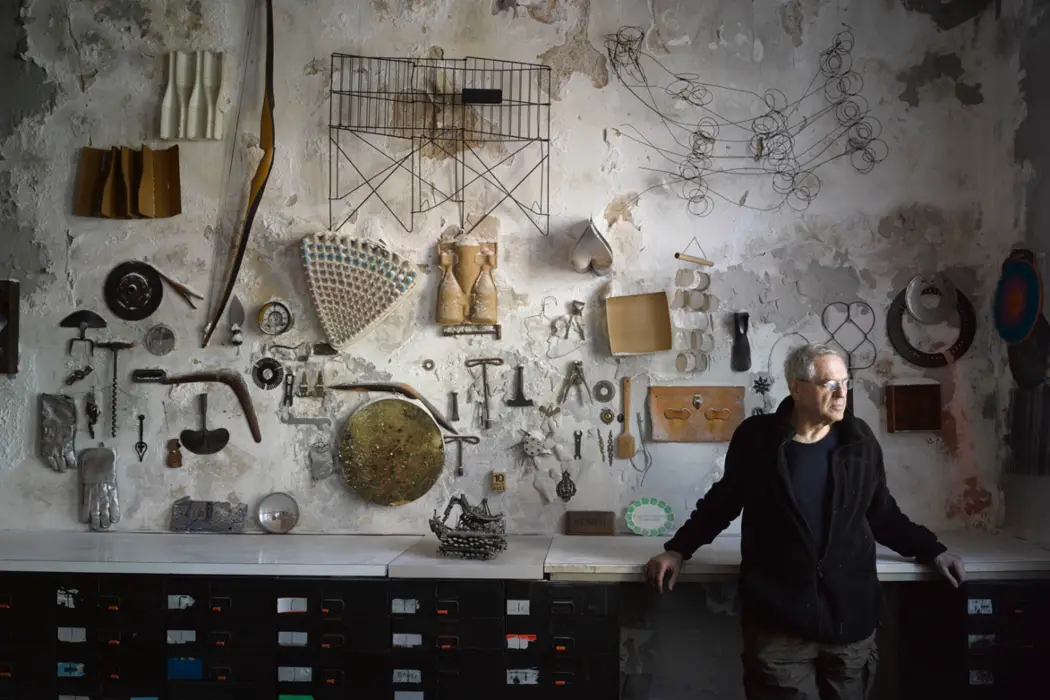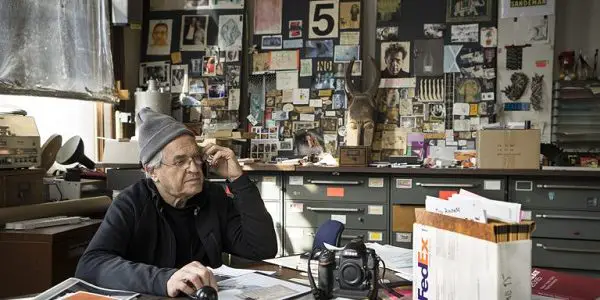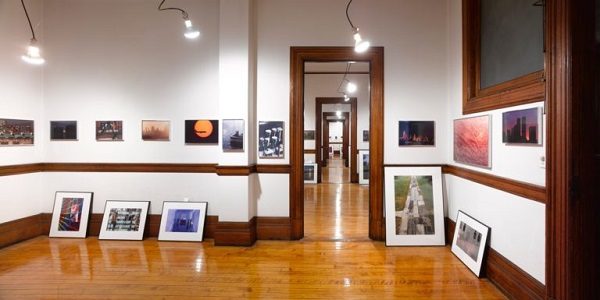JAY MYSELF: Clutter King Retraces 50 Years Of Collected Gems

Janet is a writer based in Salt Lake City. A…
“Art is trying to make others see what you see.” Jay Maisel sits in his 72-room home and former bank, reminiscing over the nearly 50 years inhabiting in such a jungle – a concrete jungle created by his incredibly unique and imaginative mind.
It’s surely a mind many colleagues and friends of Maisel have jokingly called “crazy” or “mentally ill.” What he sees in his six-story, clutter-filled home is most often looked upon as junk. There are numerous shelves, drawers (48,000 to be exact), and tables filled with anything and everything from table legs, brass and metal objects to old screwdrivers…you name it. These are objects that hold great value to the photographer; he’s collected them over the past 50 years and showcases them with the utmost pride and admiration.
It’s all an awe worthy, and at the same time, atrocious plethora of 50 years worth of collections by Maisel. The atrocity comes with the challenge of packing all the collected items out of his home on 190 Bowery in New York City. Not to mention, determining which ones to throw out and which ones to keep. Even the tiniest of these trinkets like a small pouch that holds three AAA batteries holds significance heavy enough for the photographer to hold onto. Clearly, he has a peculiar eye, and he’s unrelentingly made a home for those items.

Jay Myself, directed by Stephen Wilkes, chronicles the five months that Maisel, with the help of a village, prepares to move out of his renown home. The documentary provides an intimate portrait of a man whose talent and career are juxtaposed with the absurdity of a 35,000-square-foot jungle that encapsulates him.
The enormity of the place reflects the extreme scale to which the artist took ownership of a vast space and turned it into a madhouse – a charming madhouse that became his. His obsession with time, space, and objects ultimately grew into a physical reality.
One Lucky Son Of A Bitch–Six Stories Worth Of Ideas, Art, And Waste
Known as a photographer and collector of objects, Maisel bought the six-story, former Germania Bank (many refer to his home as “The Bank”) in 1966. Recalling feeling like the “luckiest son of a bitch,” all signs were pointing in the right direction after visiting the building. He was able to afford the down payment thanks to a well-timed photography project.
It was basically every artist’s dream and haven -having an enormous amount of space to spread out your craft however you wanted. Certainly an ode to Maisel’s life and career, Jay Myself is a celebration, remembering the life and work he created in The Bank.

Unable to further support the building’s expenses (approximately $300,000 a month), Maisel sold his home in 2015 for $55 million. It was the largest private real estate deal in New York City’s history. And of course, it began what was probably the largest and most difficult moving task force involving approximately 35 trucks.
An Artistic And Intellectual Haven
The documentary comes from a personal place, as Maisel has been Wilkes’ mentor and close friend for almost 30 years. The filmmaker captures a man with a clear vision behind the lens amid all the clutter.
Wilkes chronicles his career, documenting tales about the teachers who inspired him to his style and work ethic from colleagues. He won the likes and respect of many for his keen eye for color contrasts and his intimate approach to each project, no matter how commercial they were.
His knack for seeing value in every, often overlooked, detail proves to be a blessing and a curse, as he moves out of his home. Maisel has to let go of things, which proves to be a taxing and melancholy project. “He keeps all the garbage and what’s not garbage, he throws away,” one mover jokingly comments.
The film illustrates how The Bank established Maisel as an individual – he became a husband, father, mentor, and well sort of a nut-job in the 72-room building. As much as he established all the space, the space really established his career, his vision, and himself. It encapsulated all of the intricate crevices of his mind; it was his canvas to which he took full reign of.
Profiling A Mentor
Photography gives Maisel the opportunity to observe the world more closely; perhaps too close that he tunes out from everything around him. With the plethora of abandoned objects that accumulates around him, The Bank, in a way, is portrayed as an escape from reality.
With its brass old-school elevator and several floors with galleries of photos and collections, it’s easy to get lost and tune out. As his daughter, Amanda Maisel puts it, “he’s completely oblivious to all the things that are relevant and important.” It would have been interesting to dive deeper into this dichotomy, and perhaps, how his perceptions and home affected his family’s own outlook on life.

And of course, as his protege and mentee, Wilkes spends time recounting his and Maisel’s time together at The Bank. Having met Wilkes when he was 19-years-old, Maisel was “larger than life” to him. Wilkes appears in the film a few times, chatting and looking over old keepsakes with Maisel and his family.
Being a close friend, Wilkes evokes a very intimate and admiring portrayal of his subject along with the new adventure he’s just treading on. He doesn’t make it overly sentimental; Wilkes is well aware of the absurdity behind his collecting (or hoarding -you be the judge) and the sort of cranky madman that he is. Moreover, he knows he’s a man with a sense of play and with that, Maisel is unapologetically himself on screen.
We can clearly see and feel Wilkes‘ deep admiration for Maisel with his questions along with the sweet anecdotes he brings up while chatting with his mentor. And this, at times, makes the film feel a bit too ingratiating. Nonetheless, we’re still attached to the idiosyncrasies of the photographer and want to stick around to witness his time at The Bank coming to an end.
Conclusion: Saying Goodbye To An Oasis & To A City
With six stories worth of city views, Maisel was able to observe the changing scenes of New York City. Maisel’s move marks the closing of an era – an era that comprised of a beautiful and ambiguous mess fueled by an art scene in the surrounding neighborhood.
Wilkes crafts an entertaining and heartfelt portrayal of a photographer and artist whose unique eye constantly evolved with The Bank. In a way, it’s a love story. It’s about appreciating the time and experiences despite the chaos and melancholy. Like how Maisel looks at object with a fresh pair of eyes, he does the same with leaving his renown home – looking onward to a new adventure.
What are some of your favorite documentaries on artists? Please share by commenting below!
Watch Jay Myself
Does content like this matter to you?
Become a Member and support film journalism. Unlock access to all of Film Inquiry`s great articles. Join a community of like-minded readers who are passionate about cinema - get access to our private members Network, give back to independent filmmakers, and more.
Janet is a writer based in Salt Lake City. A strong advocate for underrepresented voices, she believes cinema is a transformative medium that challenges assumptions and creates diverse conversations.













